ENGG5103 Safety Systems and Risk Analysis: Deepwater Horizon Case
VerifiedAdded on 2023/06/08
|17
|4285
|99
Case Study
AI Summary
This report analyzes the Deepwater Horizon disaster, a major oil spill incident at the Macondo Prospect in the Gulf of Mexico on April 20, 2010. The incident, resulting in 11 fatalities, stemmed from operational failures within BP's drilling procedures. The report details the incident's timeline, the extent of the oil spill, and its environmental and health consequences, including the contamination of ocean waters and health problems among cleanup workers. It identifies critical failures in safety systems, such as the use of substandard cement, the failure of blowout preventers, and misinterpreted pressure test results. Furthermore, the report offers preventive measures and recommendations, emphasizing the need for stringent safety protocols, chemical hazard management, and environmental pollution prevention to mitigate the risk of similar incidents in the future. This analysis aims to provide a comprehensive understanding of the disaster and inform future safety practices in the petroleum industry.

[Safety system and Risk Analysis]
Paraphrase This Document
Need a fresh take? Get an instant paraphrase of this document with our AI Paraphraser
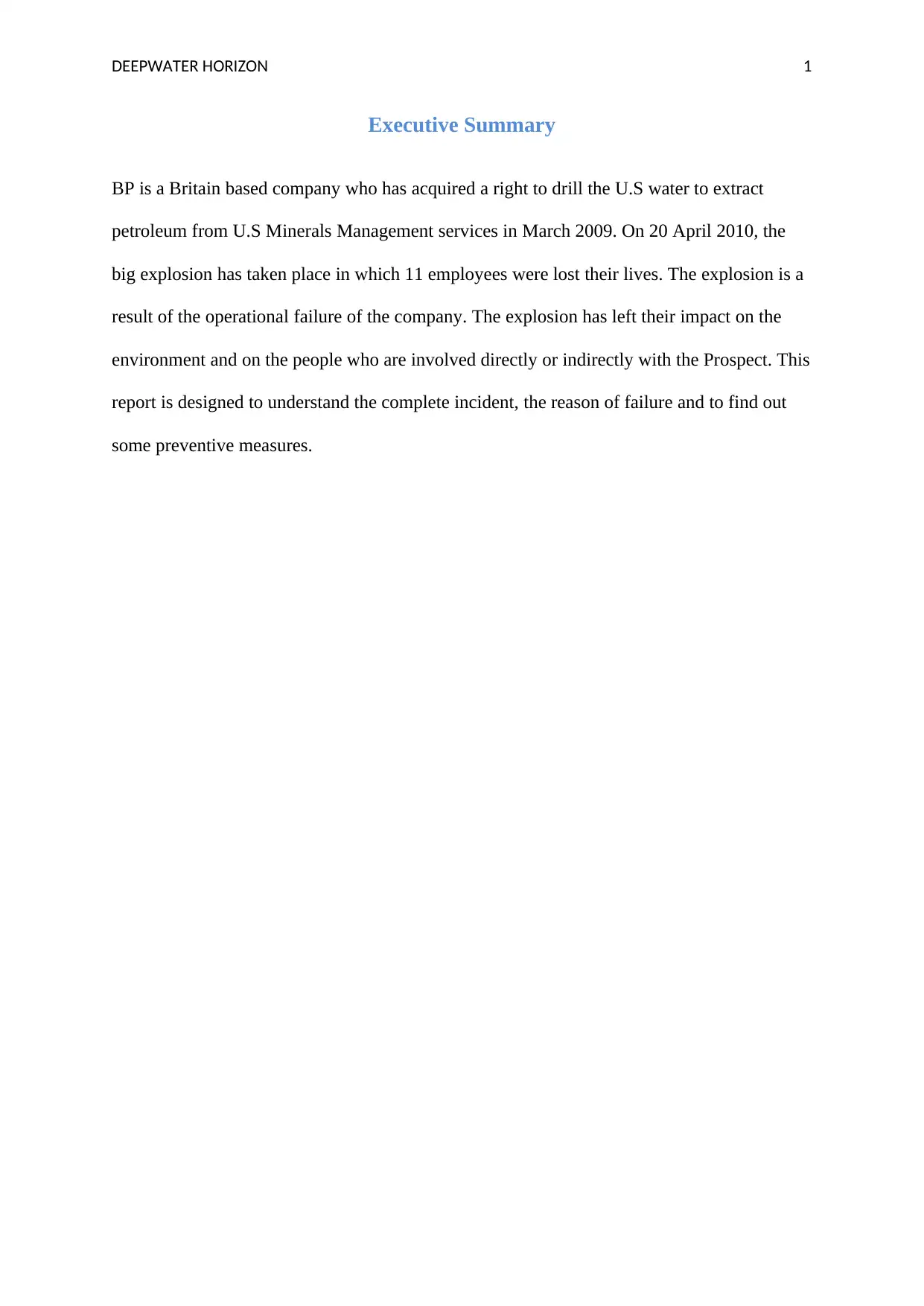
DEEPWATER HORIZON 1
Executive Summary
BP is a Britain based company who has acquired a right to drill the U.S water to extract
petroleum from U.S Minerals Management services in March 2009. On 20 April 2010, the
big explosion has taken place in which 11 employees were lost their lives. The explosion is a
result of the operational failure of the company. The explosion has left their impact on the
environment and on the people who are involved directly or indirectly with the Prospect. This
report is designed to understand the complete incident, the reason of failure and to find out
some preventive measures.
Executive Summary
BP is a Britain based company who has acquired a right to drill the U.S water to extract
petroleum from U.S Minerals Management services in March 2009. On 20 April 2010, the
big explosion has taken place in which 11 employees were lost their lives. The explosion is a
result of the operational failure of the company. The explosion has left their impact on the
environment and on the people who are involved directly or indirectly with the Prospect. This
report is designed to understand the complete incident, the reason of failure and to find out
some preventive measures.
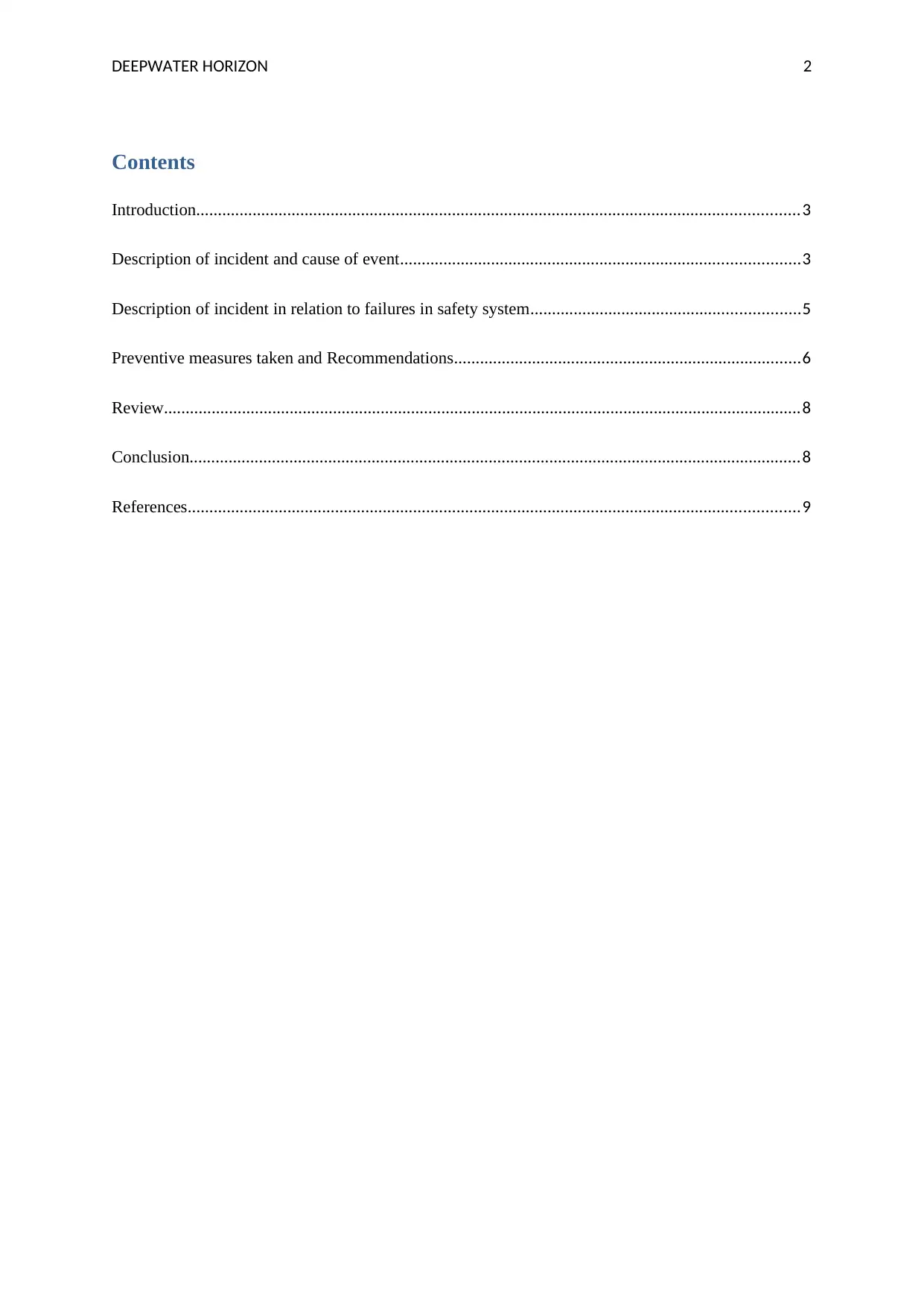
DEEPWATER HORIZON 2
Contents
Introduction...........................................................................................................................................3
Description of incident and cause of event............................................................................................3
Description of incident in relation to failures in safety system..............................................................5
Preventive measures taken and Recommendations................................................................................6
Review...................................................................................................................................................8
Conclusion.............................................................................................................................................8
References.............................................................................................................................................9
Contents
Introduction...........................................................................................................................................3
Description of incident and cause of event............................................................................................3
Description of incident in relation to failures in safety system..............................................................5
Preventive measures taken and Recommendations................................................................................6
Review...................................................................................................................................................8
Conclusion.............................................................................................................................................8
References.............................................................................................................................................9
⊘ This is a preview!⊘
Do you want full access?
Subscribe today to unlock all pages.

Trusted by 1+ million students worldwide
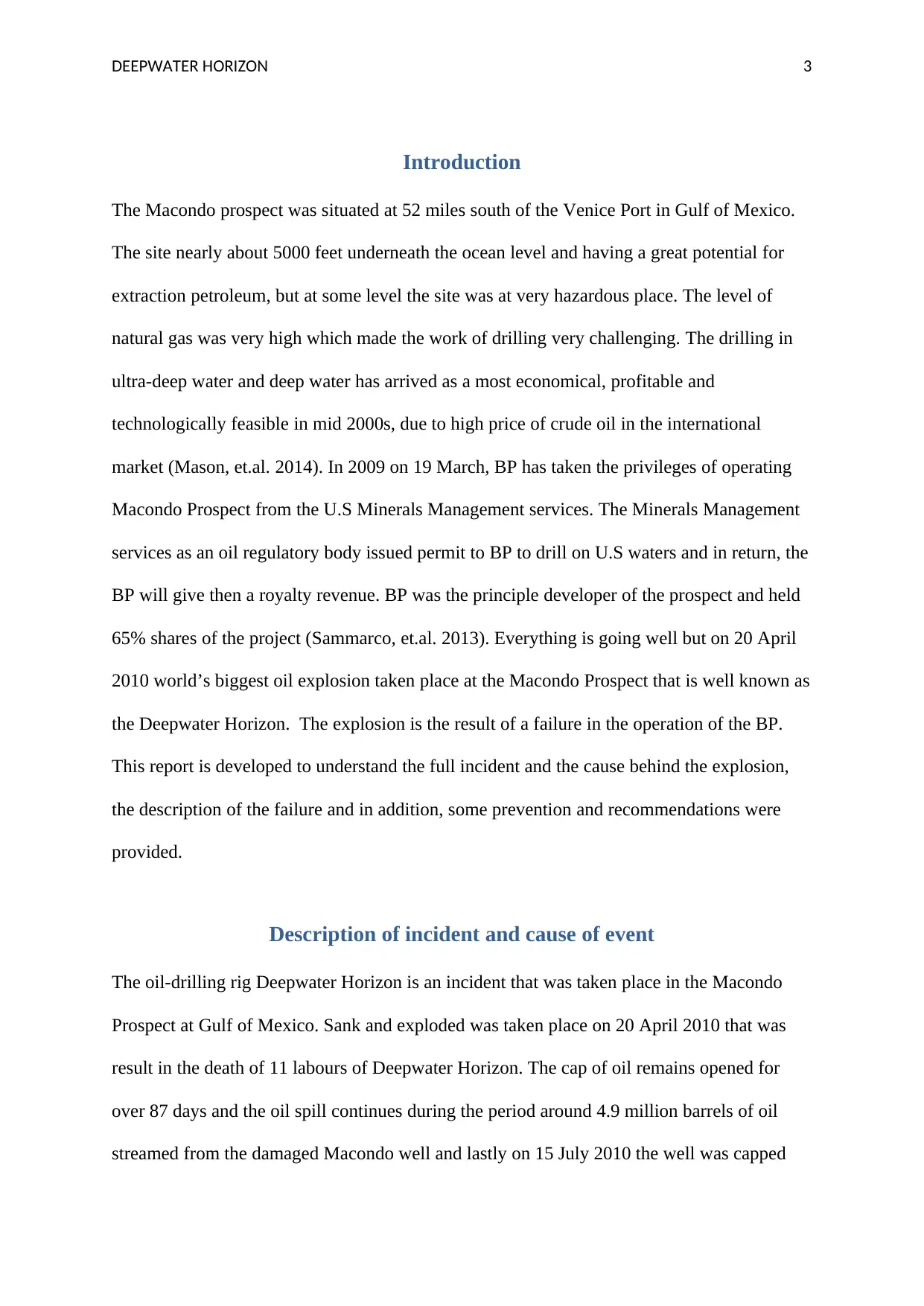
DEEPWATER HORIZON 3
Introduction
The Macondo prospect was situated at 52 miles south of the Venice Port in Gulf of Mexico.
The site nearly about 5000 feet underneath the ocean level and having a great potential for
extraction petroleum, but at some level the site was at very hazardous place. The level of
natural gas was very high which made the work of drilling very challenging. The drilling in
ultra-deep water and deep water has arrived as a most economical, profitable and
technologically feasible in mid 2000s, due to high price of crude oil in the international
market (Mason, et.al. 2014). In 2009 on 19 March, BP has taken the privileges of operating
Macondo Prospect from the U.S Minerals Management services. The Minerals Management
services as an oil regulatory body issued permit to BP to drill on U.S waters and in return, the
BP will give then a royalty revenue. BP was the principle developer of the prospect and held
65% shares of the project (Sammarco, et.al. 2013). Everything is going well but on 20 April
2010 world’s biggest oil explosion taken place at the Macondo Prospect that is well known as
the Deepwater Horizon. The explosion is the result of a failure in the operation of the BP.
This report is developed to understand the full incident and the cause behind the explosion,
the description of the failure and in addition, some prevention and recommendations were
provided.
Description of incident and cause of event
The oil-drilling rig Deepwater Horizon is an incident that was taken place in the Macondo
Prospect at Gulf of Mexico. Sank and exploded was taken place on 20 April 2010 that was
result in the death of 11 labours of Deepwater Horizon. The cap of oil remains opened for
over 87 days and the oil spill continues during the period around 4.9 million barrels of oil
streamed from the damaged Macondo well and lastly on 15 July 2010 the well was capped
Introduction
The Macondo prospect was situated at 52 miles south of the Venice Port in Gulf of Mexico.
The site nearly about 5000 feet underneath the ocean level and having a great potential for
extraction petroleum, but at some level the site was at very hazardous place. The level of
natural gas was very high which made the work of drilling very challenging. The drilling in
ultra-deep water and deep water has arrived as a most economical, profitable and
technologically feasible in mid 2000s, due to high price of crude oil in the international
market (Mason, et.al. 2014). In 2009 on 19 March, BP has taken the privileges of operating
Macondo Prospect from the U.S Minerals Management services. The Minerals Management
services as an oil regulatory body issued permit to BP to drill on U.S waters and in return, the
BP will give then a royalty revenue. BP was the principle developer of the prospect and held
65% shares of the project (Sammarco, et.al. 2013). Everything is going well but on 20 April
2010 world’s biggest oil explosion taken place at the Macondo Prospect that is well known as
the Deepwater Horizon. The explosion is the result of a failure in the operation of the BP.
This report is developed to understand the full incident and the cause behind the explosion,
the description of the failure and in addition, some prevention and recommendations were
provided.
Description of incident and cause of event
The oil-drilling rig Deepwater Horizon is an incident that was taken place in the Macondo
Prospect at Gulf of Mexico. Sank and exploded was taken place on 20 April 2010 that was
result in the death of 11 labours of Deepwater Horizon. The cap of oil remains opened for
over 87 days and the oil spill continues during the period around 4.9 million barrels of oil
streamed from the damaged Macondo well and lastly on 15 July 2010 the well was capped
Paraphrase This Document
Need a fresh take? Get an instant paraphrase of this document with our AI Paraphraser
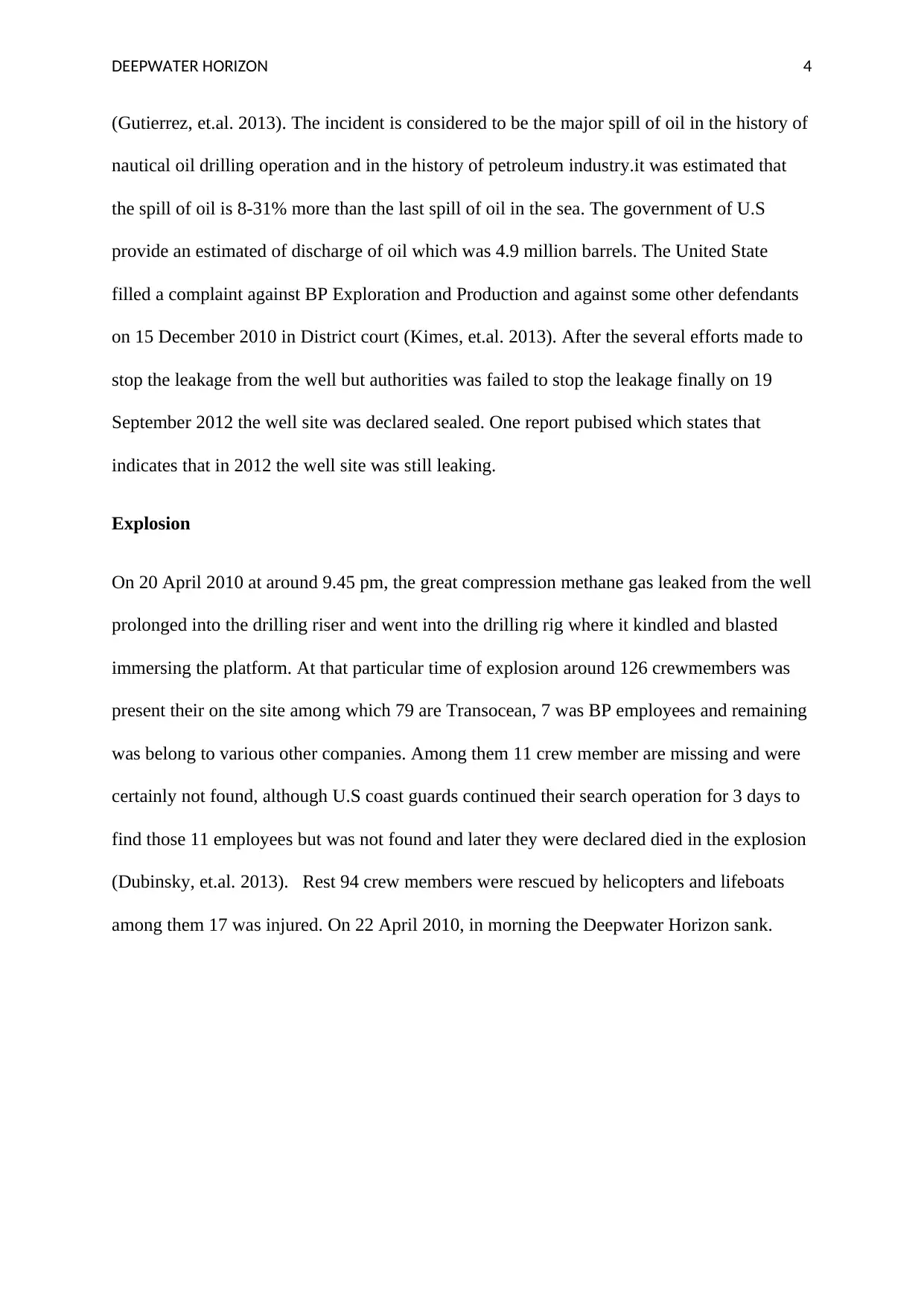
DEEPWATER HORIZON 4
(Gutierrez, et.al. 2013). The incident is considered to be the major spill of oil in the history of
nautical oil drilling operation and in the history of petroleum industry.it was estimated that
the spill of oil is 8-31% more than the last spill of oil in the sea. The government of U.S
provide an estimated of discharge of oil which was 4.9 million barrels. The United State
filled a complaint against BP Exploration and Production and against some other defendants
on 15 December 2010 in District court (Kimes, et.al. 2013). After the several efforts made to
stop the leakage from the well but authorities was failed to stop the leakage finally on 19
September 2012 the well site was declared sealed. One report pubised which states that
indicates that in 2012 the well site was still leaking.
Explosion
On 20 April 2010 at around 9.45 pm, the great compression methane gas leaked from the well
prolonged into the drilling riser and went into the drilling rig where it kindled and blasted
immersing the platform. At that particular time of explosion around 126 crewmembers was
present their on the site among which 79 are Transocean, 7 was BP employees and remaining
was belong to various other companies. Among them 11 crew member are missing and were
certainly not found, although U.S coast guards continued their search operation for 3 days to
find those 11 employees but was not found and later they were declared died in the explosion
(Dubinsky, et.al. 2013). Rest 94 crew members were rescued by helicopters and lifeboats
among them 17 was injured. On 22 April 2010, in morning the Deepwater Horizon sank.
(Gutierrez, et.al. 2013). The incident is considered to be the major spill of oil in the history of
nautical oil drilling operation and in the history of petroleum industry.it was estimated that
the spill of oil is 8-31% more than the last spill of oil in the sea. The government of U.S
provide an estimated of discharge of oil which was 4.9 million barrels. The United State
filled a complaint against BP Exploration and Production and against some other defendants
on 15 December 2010 in District court (Kimes, et.al. 2013). After the several efforts made to
stop the leakage from the well but authorities was failed to stop the leakage finally on 19
September 2012 the well site was declared sealed. One report pubised which states that
indicates that in 2012 the well site was still leaking.
Explosion
On 20 April 2010 at around 9.45 pm, the great compression methane gas leaked from the well
prolonged into the drilling riser and went into the drilling rig where it kindled and blasted
immersing the platform. At that particular time of explosion around 126 crewmembers was
present their on the site among which 79 are Transocean, 7 was BP employees and remaining
was belong to various other companies. Among them 11 crew member are missing and were
certainly not found, although U.S coast guards continued their search operation for 3 days to
find those 11 employees but was not found and later they were declared died in the explosion
(Dubinsky, et.al. 2013). Rest 94 crew members were rescued by helicopters and lifeboats
among them 17 was injured. On 22 April 2010, in morning the Deepwater Horizon sank.
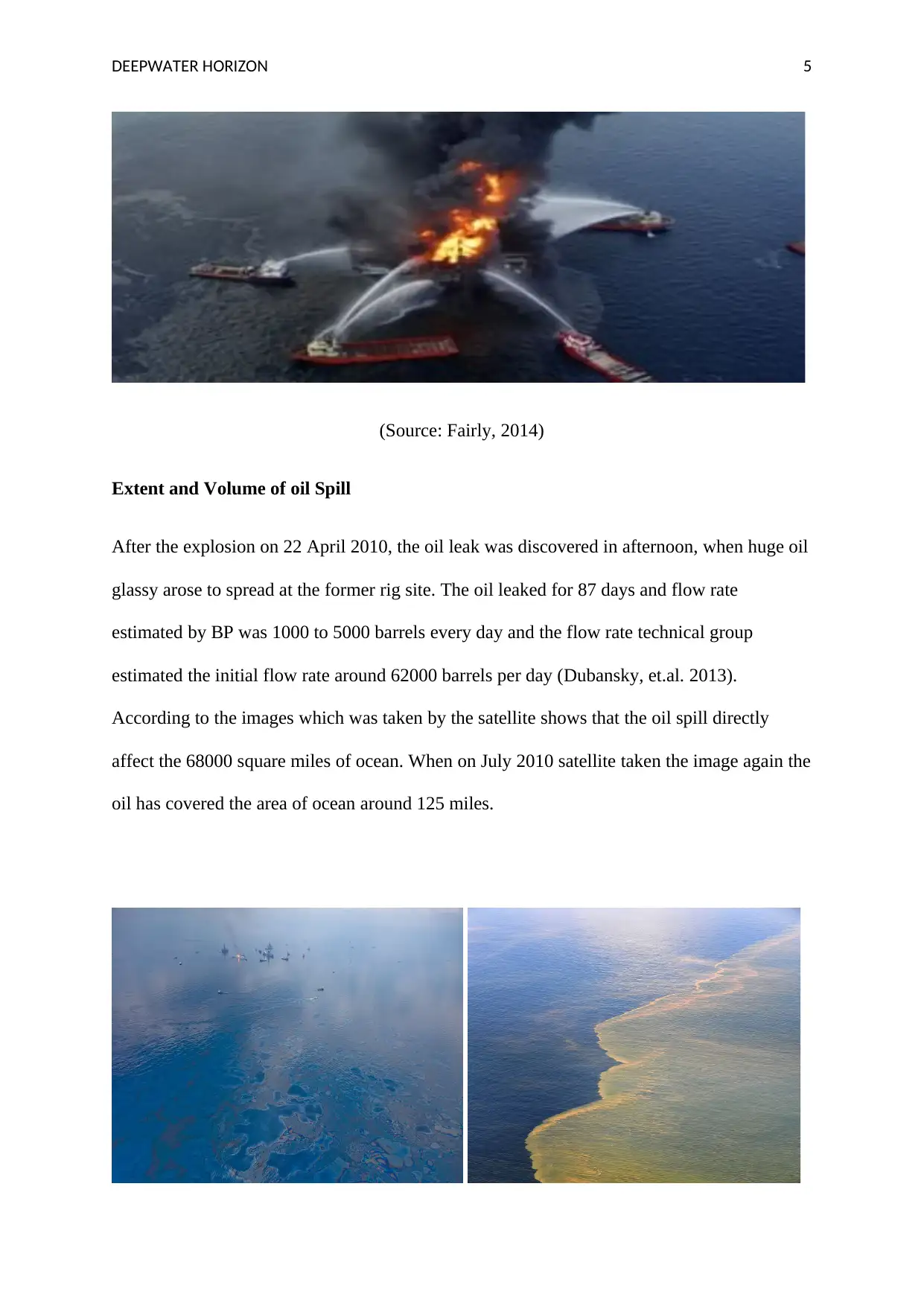
DEEPWATER HORIZON 5
(Source: Fairly, 2014)
Extent and Volume of oil Spill
After the explosion on 22 April 2010, the oil leak was discovered in afternoon, when huge oil
glassy arose to spread at the former rig site. The oil leaked for 87 days and flow rate
estimated by BP was 1000 to 5000 barrels every day and the flow rate technical group
estimated the initial flow rate around 62000 barrels per day (Dubansky, et.al. 2013).
According to the images which was taken by the satellite shows that the oil spill directly
affect the 68000 square miles of ocean. When on July 2010 satellite taken the image again the
oil has covered the area of ocean around 125 miles.
(Source: Fairly, 2014)
Extent and Volume of oil Spill
After the explosion on 22 April 2010, the oil leak was discovered in afternoon, when huge oil
glassy arose to spread at the former rig site. The oil leaked for 87 days and flow rate
estimated by BP was 1000 to 5000 barrels every day and the flow rate technical group
estimated the initial flow rate around 62000 barrels per day (Dubansky, et.al. 2013).
According to the images which was taken by the satellite shows that the oil spill directly
affect the 68000 square miles of ocean. When on July 2010 satellite taken the image again the
oil has covered the area of ocean around 125 miles.
⊘ This is a preview!⊘
Do you want full access?
Subscribe today to unlock all pages.

Trusted by 1+ million students worldwide
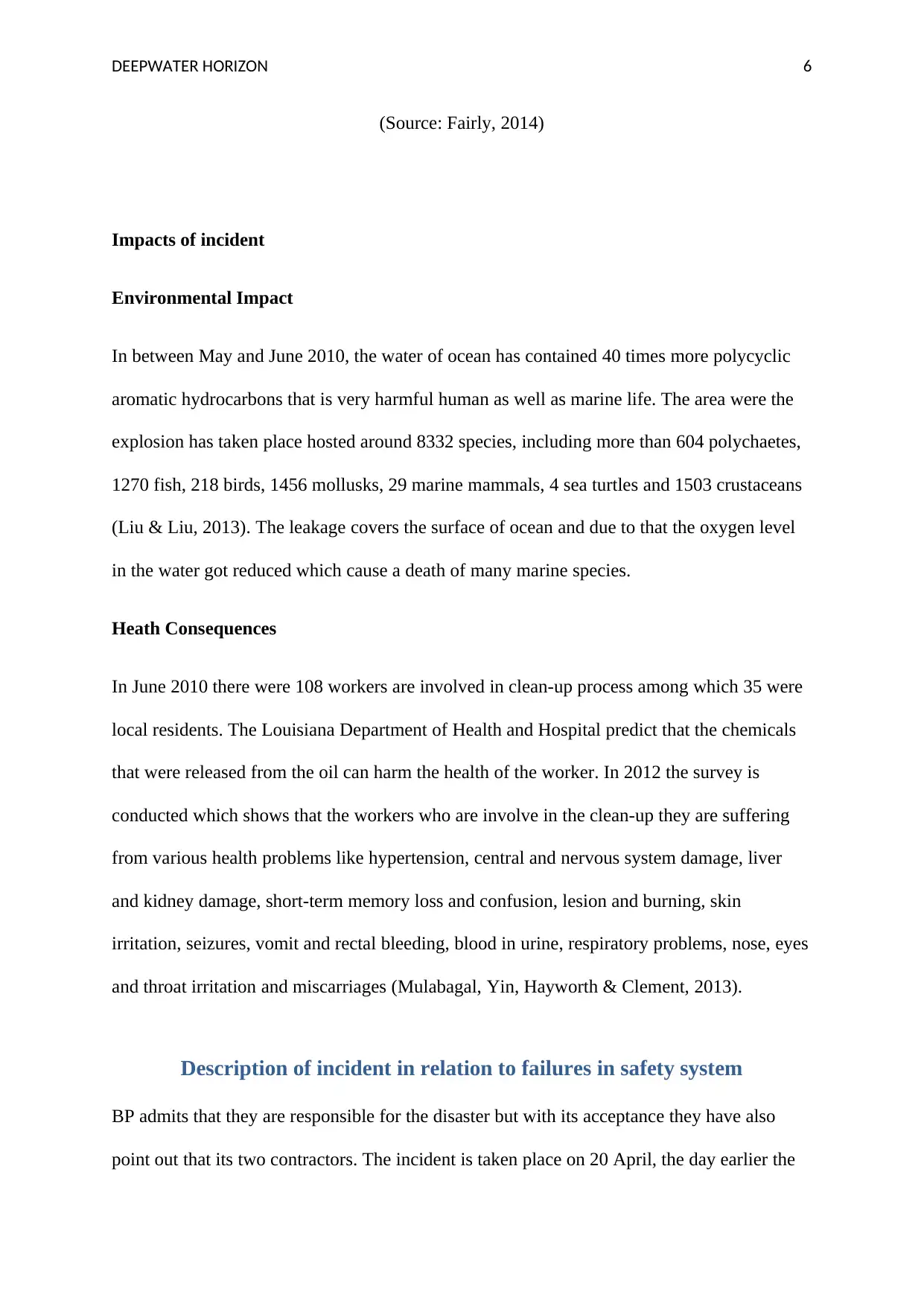
DEEPWATER HORIZON 6
(Source: Fairly, 2014)
Impacts of incident
Environmental Impact
In between May and June 2010, the water of ocean has contained 40 times more polycyclic
aromatic hydrocarbons that is very harmful human as well as marine life. The area were the
explosion has taken place hosted around 8332 species, including more than 604 polychaetes,
1270 fish, 218 birds, 1456 mollusks, 29 marine mammals, 4 sea turtles and 1503 crustaceans
(Liu & Liu, 2013). The leakage covers the surface of ocean and due to that the oxygen level
in the water got reduced which cause a death of many marine species.
Heath Consequences
In June 2010 there were 108 workers are involved in clean-up process among which 35 were
local residents. The Louisiana Department of Health and Hospital predict that the chemicals
that were released from the oil can harm the health of the worker. In 2012 the survey is
conducted which shows that the workers who are involve in the clean-up they are suffering
from various health problems like hypertension, central and nervous system damage, liver
and kidney damage, short-term memory loss and confusion, lesion and burning, skin
irritation, seizures, vomit and rectal bleeding, blood in urine, respiratory problems, nose, eyes
and throat irritation and miscarriages (Mulabagal, Yin, Hayworth & Clement, 2013).
Description of incident in relation to failures in safety system
BP admits that they are responsible for the disaster but with its acceptance they have also
point out that its two contractors. The incident is taken place on 20 April, the day earlier the
(Source: Fairly, 2014)
Impacts of incident
Environmental Impact
In between May and June 2010, the water of ocean has contained 40 times more polycyclic
aromatic hydrocarbons that is very harmful human as well as marine life. The area were the
explosion has taken place hosted around 8332 species, including more than 604 polychaetes,
1270 fish, 218 birds, 1456 mollusks, 29 marine mammals, 4 sea turtles and 1503 crustaceans
(Liu & Liu, 2013). The leakage covers the surface of ocean and due to that the oxygen level
in the water got reduced which cause a death of many marine species.
Heath Consequences
In June 2010 there were 108 workers are involved in clean-up process among which 35 were
local residents. The Louisiana Department of Health and Hospital predict that the chemicals
that were released from the oil can harm the health of the worker. In 2012 the survey is
conducted which shows that the workers who are involve in the clean-up they are suffering
from various health problems like hypertension, central and nervous system damage, liver
and kidney damage, short-term memory loss and confusion, lesion and burning, skin
irritation, seizures, vomit and rectal bleeding, blood in urine, respiratory problems, nose, eyes
and throat irritation and miscarriages (Mulabagal, Yin, Hayworth & Clement, 2013).
Description of incident in relation to failures in safety system
BP admits that they are responsible for the disaster but with its acceptance they have also
point out that its two contractors. The incident is taken place on 20 April, the day earlier the
Paraphrase This Document
Need a fresh take? Get an instant paraphrase of this document with our AI Paraphraser
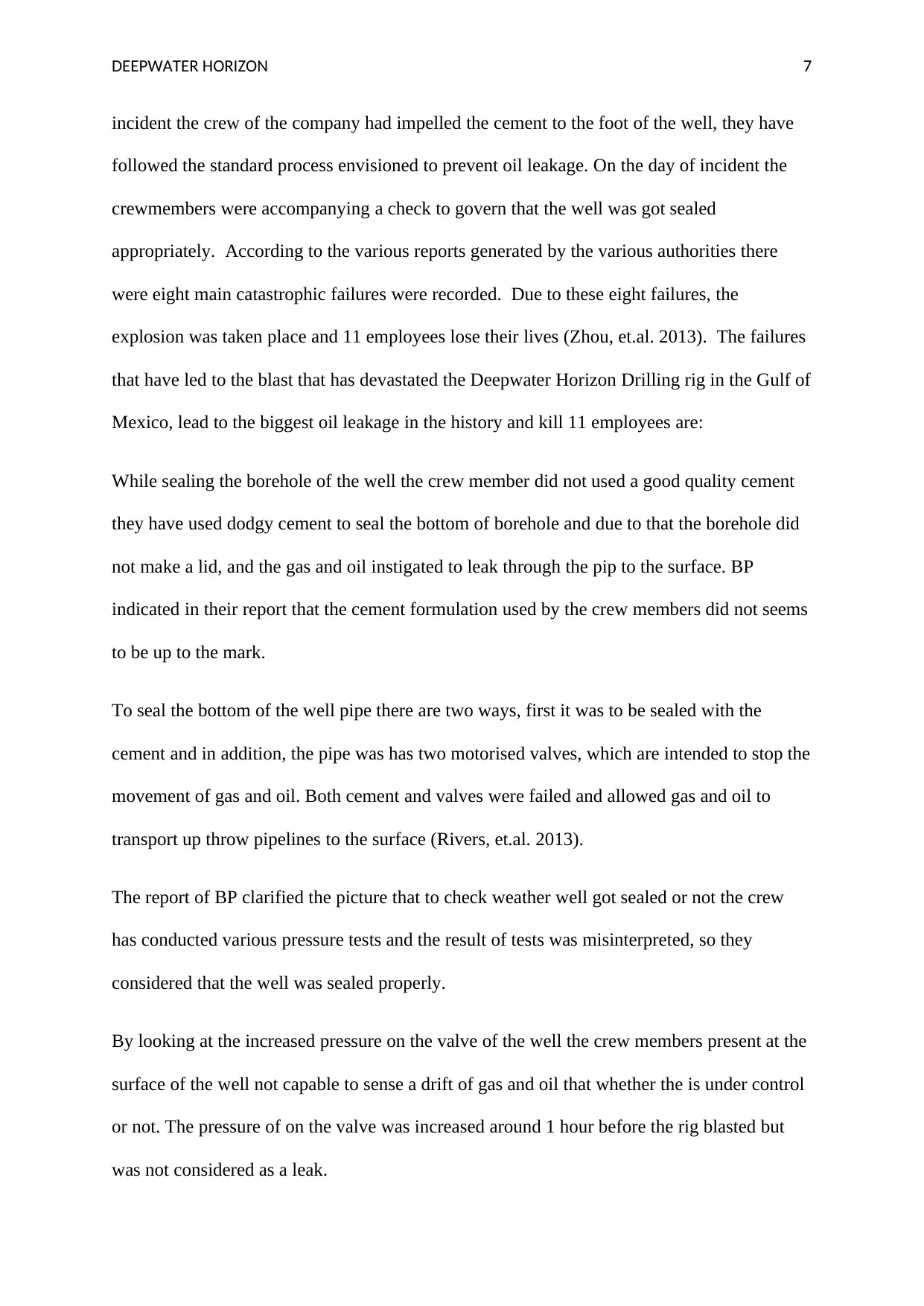
DEEPWATER HORIZON 7
incident the crew of the company had impelled the cement to the foot of the well, they have
followed the standard process envisioned to prevent oil leakage. On the day of incident the
crewmembers were accompanying a check to govern that the well was got sealed
appropriately. According to the various reports generated by the various authorities there
were eight main catastrophic failures were recorded. Due to these eight failures, the
explosion was taken place and 11 employees lose their lives (Zhou, et.al. 2013). The failures
that have led to the blast that has devastated the Deepwater Horizon Drilling rig in the Gulf of
Mexico, lead to the biggest oil leakage in the history and kill 11 employees are:
While sealing the borehole of the well the crew member did not used a good quality cement
they have used dodgy cement to seal the bottom of borehole and due to that the borehole did
not make a lid, and the gas and oil instigated to leak through the pip to the surface. BP
indicated in their report that the cement formulation used by the crew members did not seems
to be up to the mark.
To seal the bottom of the well pipe there are two ways, first it was to be sealed with the
cement and in addition, the pipe was has two motorised valves, which are intended to stop the
movement of gas and oil. Both cement and valves were failed and allowed gas and oil to
transport up throw pipelines to the surface (Rivers, et.al. 2013).
The report of BP clarified the picture that to check weather well got sealed or not the crew
has conducted various pressure tests and the result of tests was misinterpreted, so they
considered that the well was sealed properly.
By looking at the increased pressure on the valve of the well the crew members present at the
surface of the well not capable to sense a drift of gas and oil that whether the is under control
or not. The pressure of on the valve was increased around 1 hour before the rig blasted but
was not considered as a leak.
incident the crew of the company had impelled the cement to the foot of the well, they have
followed the standard process envisioned to prevent oil leakage. On the day of incident the
crewmembers were accompanying a check to govern that the well was got sealed
appropriately. According to the various reports generated by the various authorities there
were eight main catastrophic failures were recorded. Due to these eight failures, the
explosion was taken place and 11 employees lose their lives (Zhou, et.al. 2013). The failures
that have led to the blast that has devastated the Deepwater Horizon Drilling rig in the Gulf of
Mexico, lead to the biggest oil leakage in the history and kill 11 employees are:
While sealing the borehole of the well the crew member did not used a good quality cement
they have used dodgy cement to seal the bottom of borehole and due to that the borehole did
not make a lid, and the gas and oil instigated to leak through the pip to the surface. BP
indicated in their report that the cement formulation used by the crew members did not seems
to be up to the mark.
To seal the bottom of the well pipe there are two ways, first it was to be sealed with the
cement and in addition, the pipe was has two motorised valves, which are intended to stop the
movement of gas and oil. Both cement and valves were failed and allowed gas and oil to
transport up throw pipelines to the surface (Rivers, et.al. 2013).
The report of BP clarified the picture that to check weather well got sealed or not the crew
has conducted various pressure tests and the result of tests was misinterpreted, so they
considered that the well was sealed properly.
By looking at the increased pressure on the valve of the well the crew members present at the
surface of the well not capable to sense a drift of gas and oil that whether the is under control
or not. The pressure of on the valve was increased around 1 hour before the rig blasted but
was not considered as a leak.
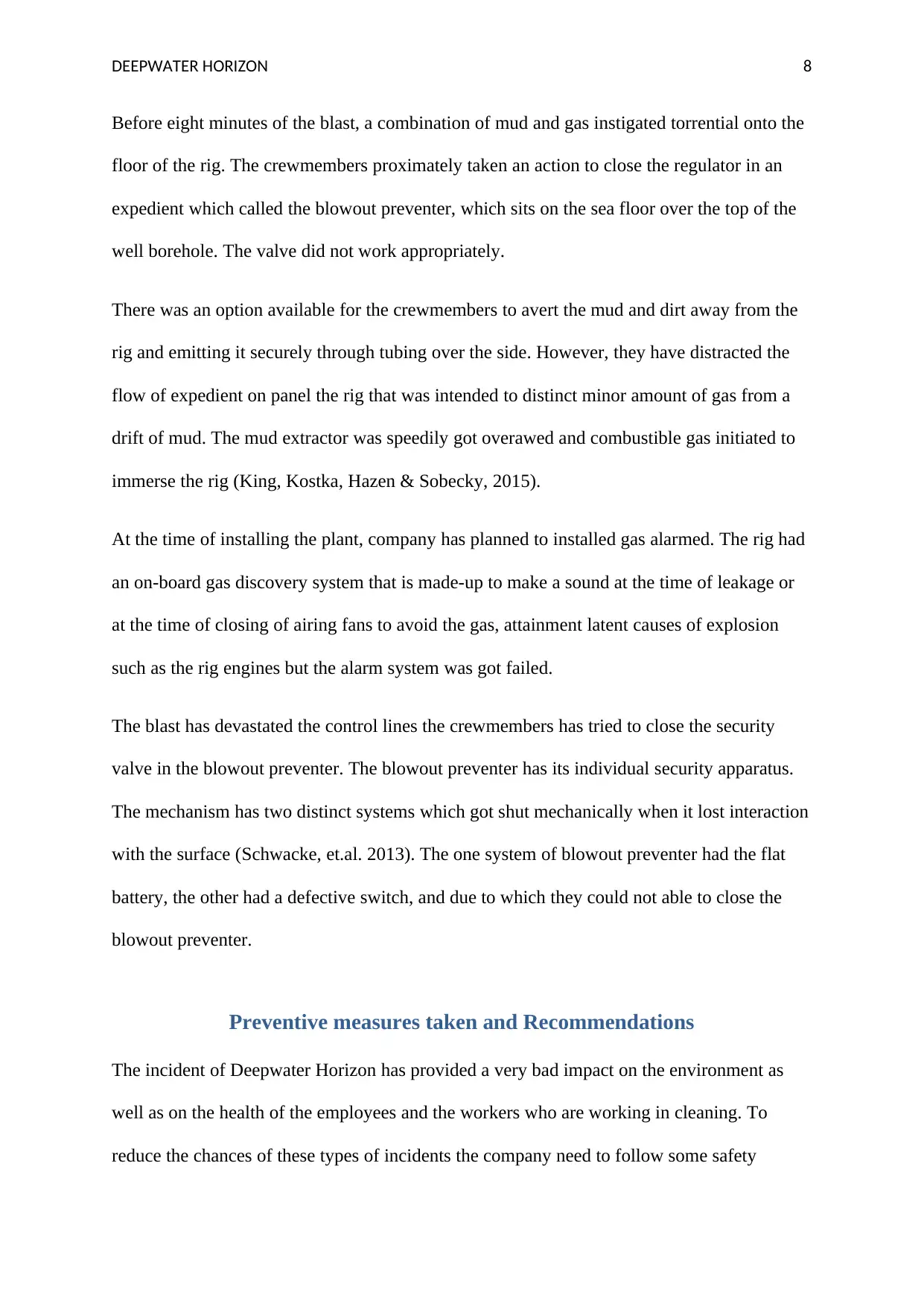
DEEPWATER HORIZON 8
Before eight minutes of the blast, a combination of mud and gas instigated torrential onto the
floor of the rig. The crewmembers proximately taken an action to close the regulator in an
expedient which called the blowout preventer, which sits on the sea floor over the top of the
well borehole. The valve did not work appropriately.
There was an option available for the crewmembers to avert the mud and dirt away from the
rig and emitting it securely through tubing over the side. However, they have distracted the
flow of expedient on panel the rig that was intended to distinct minor amount of gas from a
drift of mud. The mud extractor was speedily got overawed and combustible gas initiated to
immerse the rig (King, Kostka, Hazen & Sobecky, 2015).
At the time of installing the plant, company has planned to installed gas alarmed. The rig had
an on-board gas discovery system that is made-up to make a sound at the time of leakage or
at the time of closing of airing fans to avoid the gas, attainment latent causes of explosion
such as the rig engines but the alarm system was got failed.
The blast has devastated the control lines the crewmembers has tried to close the security
valve in the blowout preventer. The blowout preventer has its individual security apparatus.
The mechanism has two distinct systems which got shut mechanically when it lost interaction
with the surface (Schwacke, et.al. 2013). The one system of blowout preventer had the flat
battery, the other had a defective switch, and due to which they could not able to close the
blowout preventer.
Preventive measures taken and Recommendations
The incident of Deepwater Horizon has provided a very bad impact on the environment as
well as on the health of the employees and the workers who are working in cleaning. To
reduce the chances of these types of incidents the company need to follow some safety
Before eight minutes of the blast, a combination of mud and gas instigated torrential onto the
floor of the rig. The crewmembers proximately taken an action to close the regulator in an
expedient which called the blowout preventer, which sits on the sea floor over the top of the
well borehole. The valve did not work appropriately.
There was an option available for the crewmembers to avert the mud and dirt away from the
rig and emitting it securely through tubing over the side. However, they have distracted the
flow of expedient on panel the rig that was intended to distinct minor amount of gas from a
drift of mud. The mud extractor was speedily got overawed and combustible gas initiated to
immerse the rig (King, Kostka, Hazen & Sobecky, 2015).
At the time of installing the plant, company has planned to installed gas alarmed. The rig had
an on-board gas discovery system that is made-up to make a sound at the time of leakage or
at the time of closing of airing fans to avoid the gas, attainment latent causes of explosion
such as the rig engines but the alarm system was got failed.
The blast has devastated the control lines the crewmembers has tried to close the security
valve in the blowout preventer. The blowout preventer has its individual security apparatus.
The mechanism has two distinct systems which got shut mechanically when it lost interaction
with the surface (Schwacke, et.al. 2013). The one system of blowout preventer had the flat
battery, the other had a defective switch, and due to which they could not able to close the
blowout preventer.
Preventive measures taken and Recommendations
The incident of Deepwater Horizon has provided a very bad impact on the environment as
well as on the health of the employees and the workers who are working in cleaning. To
reduce the chances of these types of incidents the company need to follow some safety
⊘ This is a preview!⊘
Do you want full access?
Subscribe today to unlock all pages.

Trusted by 1+ million students worldwide
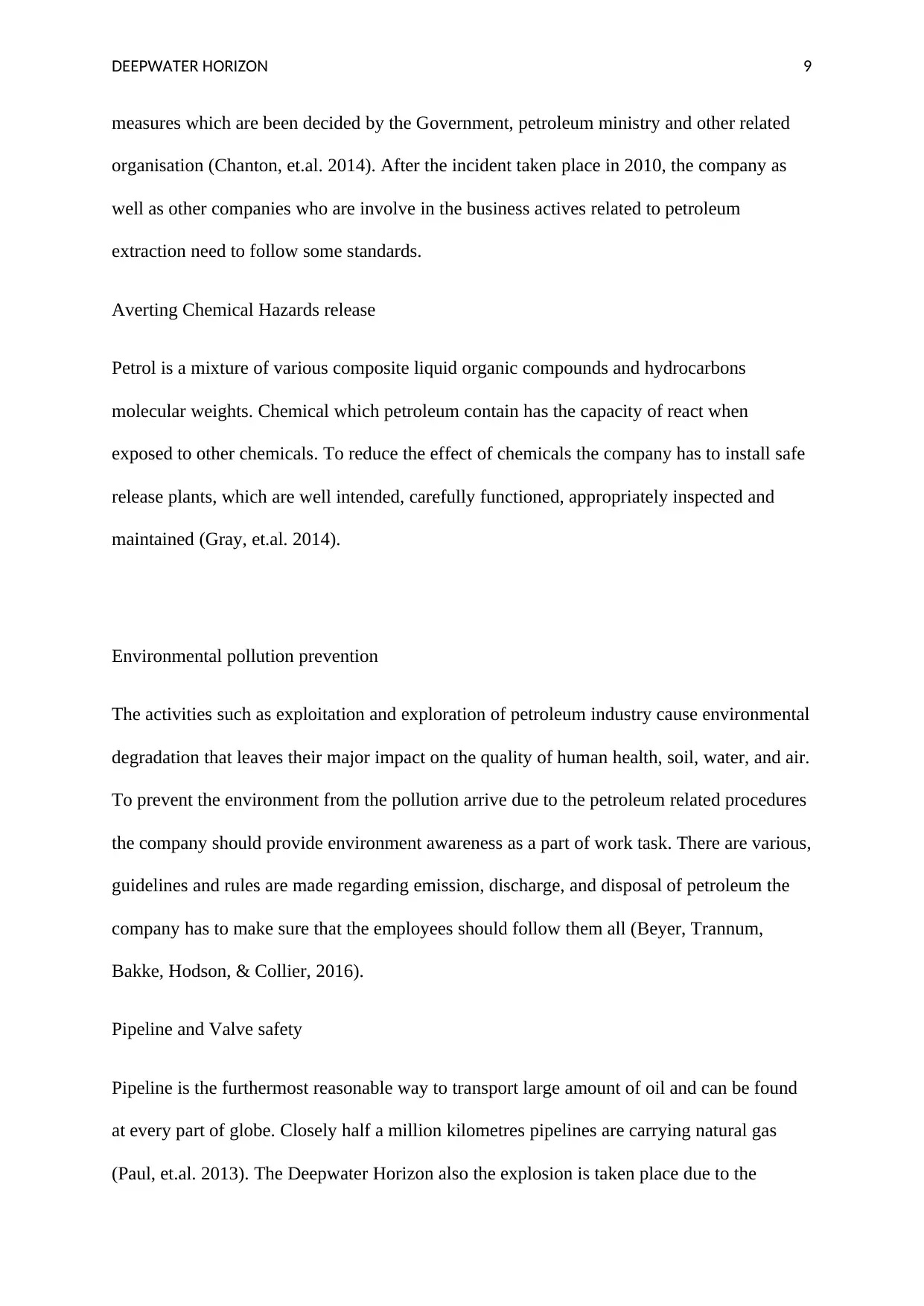
DEEPWATER HORIZON 9
measures which are been decided by the Government, petroleum ministry and other related
organisation (Chanton, et.al. 2014). After the incident taken place in 2010, the company as
well as other companies who are involve in the business actives related to petroleum
extraction need to follow some standards.
Averting Chemical Hazards release
Petrol is a mixture of various composite liquid organic compounds and hydrocarbons
molecular weights. Chemical which petroleum contain has the capacity of react when
exposed to other chemicals. To reduce the effect of chemicals the company has to install safe
release plants, which are well intended, carefully functioned, appropriately inspected and
maintained (Gray, et.al. 2014).
Environmental pollution prevention
The activities such as exploitation and exploration of petroleum industry cause environmental
degradation that leaves their major impact on the quality of human health, soil, water, and air.
To prevent the environment from the pollution arrive due to the petroleum related procedures
the company should provide environment awareness as a part of work task. There are various,
guidelines and rules are made regarding emission, discharge, and disposal of petroleum the
company has to make sure that the employees should follow them all (Beyer, Trannum,
Bakke, Hodson, & Collier, 2016).
Pipeline and Valve safety
Pipeline is the furthermost reasonable way to transport large amount of oil and can be found
at every part of globe. Closely half a million kilometres pipelines are carrying natural gas
(Paul, et.al. 2013). The Deepwater Horizon also the explosion is taken place due to the
measures which are been decided by the Government, petroleum ministry and other related
organisation (Chanton, et.al. 2014). After the incident taken place in 2010, the company as
well as other companies who are involve in the business actives related to petroleum
extraction need to follow some standards.
Averting Chemical Hazards release
Petrol is a mixture of various composite liquid organic compounds and hydrocarbons
molecular weights. Chemical which petroleum contain has the capacity of react when
exposed to other chemicals. To reduce the effect of chemicals the company has to install safe
release plants, which are well intended, carefully functioned, appropriately inspected and
maintained (Gray, et.al. 2014).
Environmental pollution prevention
The activities such as exploitation and exploration of petroleum industry cause environmental
degradation that leaves their major impact on the quality of human health, soil, water, and air.
To prevent the environment from the pollution arrive due to the petroleum related procedures
the company should provide environment awareness as a part of work task. There are various,
guidelines and rules are made regarding emission, discharge, and disposal of petroleum the
company has to make sure that the employees should follow them all (Beyer, Trannum,
Bakke, Hodson, & Collier, 2016).
Pipeline and Valve safety
Pipeline is the furthermost reasonable way to transport large amount of oil and can be found
at every part of globe. Closely half a million kilometres pipelines are carrying natural gas
(Paul, et.al. 2013). The Deepwater Horizon also the explosion is taken place due to the
Paraphrase This Document
Need a fresh take? Get an instant paraphrase of this document with our AI Paraphraser
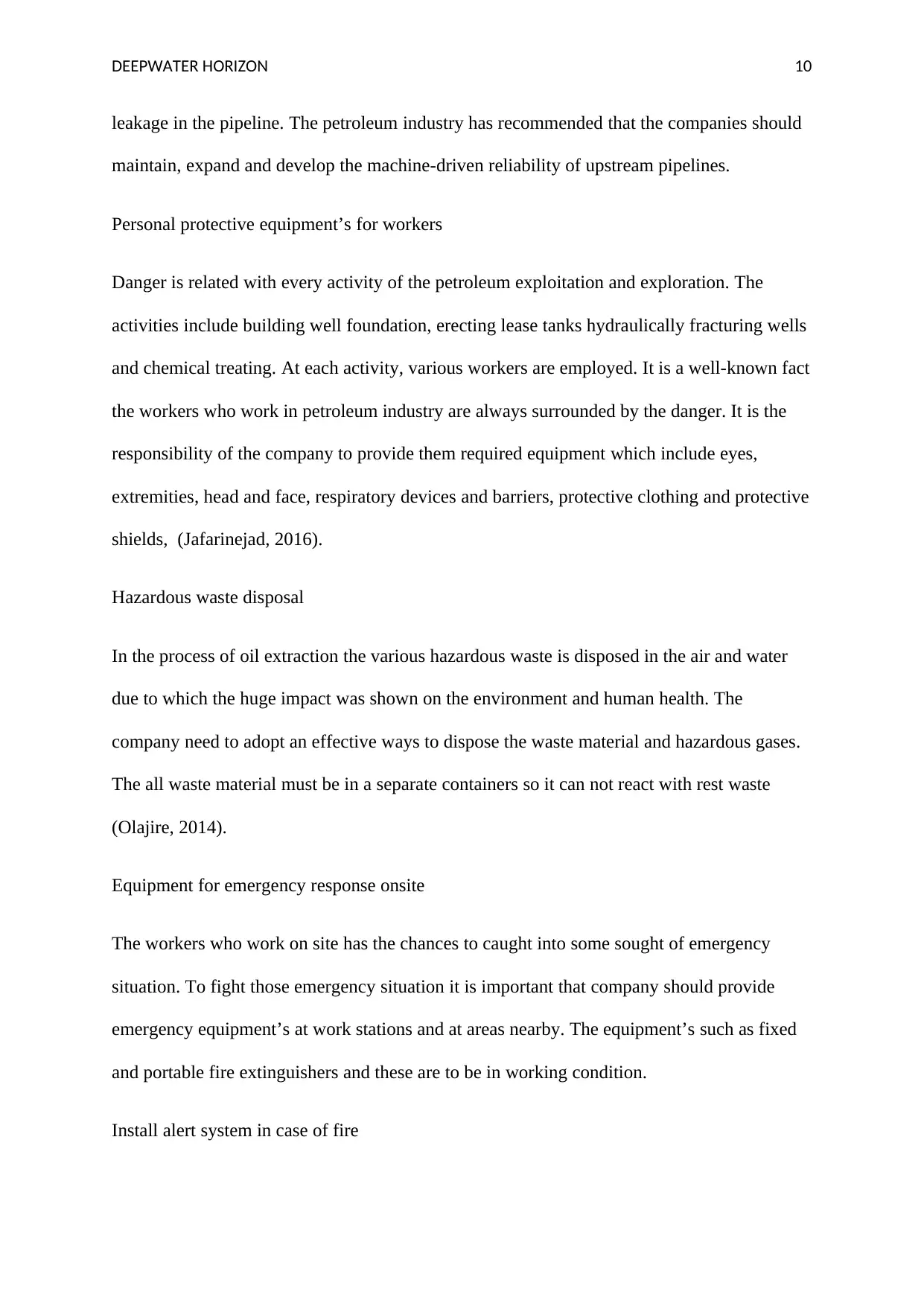
DEEPWATER HORIZON 10
leakage in the pipeline. The petroleum industry has recommended that the companies should
maintain, expand and develop the machine-driven reliability of upstream pipelines.
Personal protective equipment’s for workers
Danger is related with every activity of the petroleum exploitation and exploration. The
activities include building well foundation, erecting lease tanks hydraulically fracturing wells
and chemical treating. At each activity, various workers are employed. It is a well-known fact
the workers who work in petroleum industry are always surrounded by the danger. It is the
responsibility of the company to provide them required equipment which include eyes,
extremities, head and face, respiratory devices and barriers, protective clothing and protective
shields, (Jafarinejad, 2016).
Hazardous waste disposal
In the process of oil extraction the various hazardous waste is disposed in the air and water
due to which the huge impact was shown on the environment and human health. The
company need to adopt an effective ways to dispose the waste material and hazardous gases.
The all waste material must be in a separate containers so it can not react with rest waste
(Olajire, 2014).
Equipment for emergency response onsite
The workers who work on site has the chances to caught into some sought of emergency
situation. To fight those emergency situation it is important that company should provide
emergency equipment’s at work stations and at areas nearby. The equipment’s such as fixed
and portable fire extinguishers and these are to be in working condition.
Install alert system in case of fire
leakage in the pipeline. The petroleum industry has recommended that the companies should
maintain, expand and develop the machine-driven reliability of upstream pipelines.
Personal protective equipment’s for workers
Danger is related with every activity of the petroleum exploitation and exploration. The
activities include building well foundation, erecting lease tanks hydraulically fracturing wells
and chemical treating. At each activity, various workers are employed. It is a well-known fact
the workers who work in petroleum industry are always surrounded by the danger. It is the
responsibility of the company to provide them required equipment which include eyes,
extremities, head and face, respiratory devices and barriers, protective clothing and protective
shields, (Jafarinejad, 2016).
Hazardous waste disposal
In the process of oil extraction the various hazardous waste is disposed in the air and water
due to which the huge impact was shown on the environment and human health. The
company need to adopt an effective ways to dispose the waste material and hazardous gases.
The all waste material must be in a separate containers so it can not react with rest waste
(Olajire, 2014).
Equipment for emergency response onsite
The workers who work on site has the chances to caught into some sought of emergency
situation. To fight those emergency situation it is important that company should provide
emergency equipment’s at work stations and at areas nearby. The equipment’s such as fixed
and portable fire extinguishers and these are to be in working condition.
Install alert system in case of fire
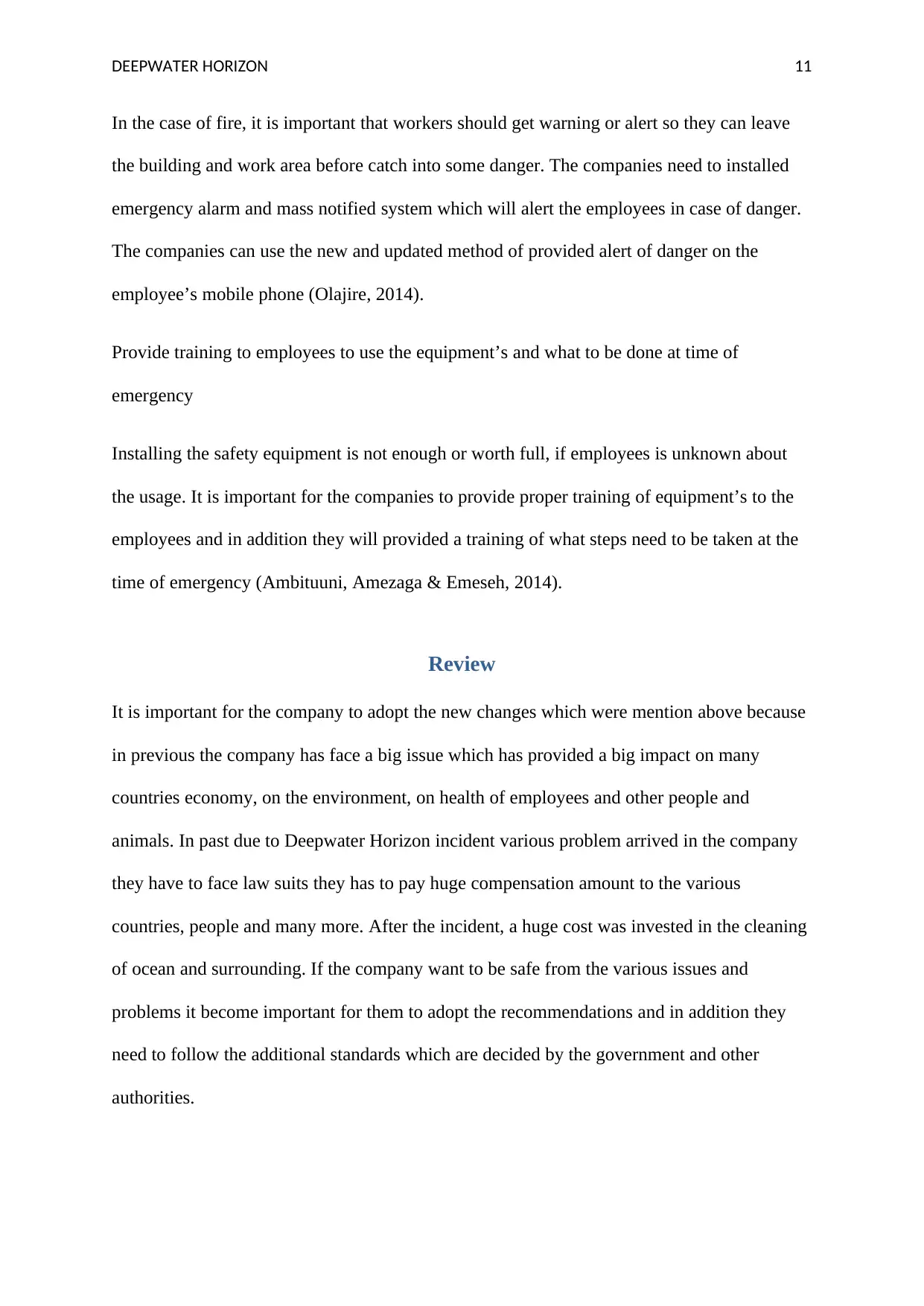
DEEPWATER HORIZON 11
In the case of fire, it is important that workers should get warning or alert so they can leave
the building and work area before catch into some danger. The companies need to installed
emergency alarm and mass notified system which will alert the employees in case of danger.
The companies can use the new and updated method of provided alert of danger on the
employee’s mobile phone (Olajire, 2014).
Provide training to employees to use the equipment’s and what to be done at time of
emergency
Installing the safety equipment is not enough or worth full, if employees is unknown about
the usage. It is important for the companies to provide proper training of equipment’s to the
employees and in addition they will provided a training of what steps need to be taken at the
time of emergency (Ambituuni, Amezaga & Emeseh, 2014).
Review
It is important for the company to adopt the new changes which were mention above because
in previous the company has face a big issue which has provided a big impact on many
countries economy, on the environment, on health of employees and other people and
animals. In past due to Deepwater Horizon incident various problem arrived in the company
they have to face law suits they has to pay huge compensation amount to the various
countries, people and many more. After the incident, a huge cost was invested in the cleaning
of ocean and surrounding. If the company want to be safe from the various issues and
problems it become important for them to adopt the recommendations and in addition they
need to follow the additional standards which are decided by the government and other
authorities.
In the case of fire, it is important that workers should get warning or alert so they can leave
the building and work area before catch into some danger. The companies need to installed
emergency alarm and mass notified system which will alert the employees in case of danger.
The companies can use the new and updated method of provided alert of danger on the
employee’s mobile phone (Olajire, 2014).
Provide training to employees to use the equipment’s and what to be done at time of
emergency
Installing the safety equipment is not enough or worth full, if employees is unknown about
the usage. It is important for the companies to provide proper training of equipment’s to the
employees and in addition they will provided a training of what steps need to be taken at the
time of emergency (Ambituuni, Amezaga & Emeseh, 2014).
Review
It is important for the company to adopt the new changes which were mention above because
in previous the company has face a big issue which has provided a big impact on many
countries economy, on the environment, on health of employees and other people and
animals. In past due to Deepwater Horizon incident various problem arrived in the company
they have to face law suits they has to pay huge compensation amount to the various
countries, people and many more. After the incident, a huge cost was invested in the cleaning
of ocean and surrounding. If the company want to be safe from the various issues and
problems it become important for them to adopt the recommendations and in addition they
need to follow the additional standards which are decided by the government and other
authorities.
⊘ This is a preview!⊘
Do you want full access?
Subscribe today to unlock all pages.

Trusted by 1+ million students worldwide
1 out of 17
Related Documents
Your All-in-One AI-Powered Toolkit for Academic Success.
+13062052269
info@desklib.com
Available 24*7 on WhatsApp / Email
![[object Object]](/_next/static/media/star-bottom.7253800d.svg)
Unlock your academic potential
Copyright © 2020–2025 A2Z Services. All Rights Reserved. Developed and managed by ZUCOL.





